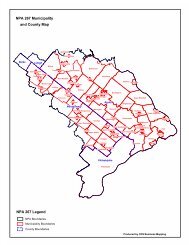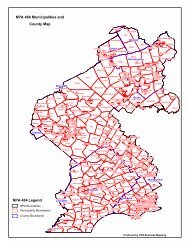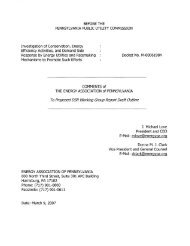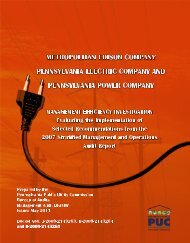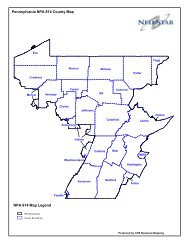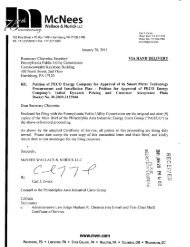2010 Report - Pennsylvania Public Utility Commission
2010 Report - Pennsylvania Public Utility Commission
2010 Report - Pennsylvania Public Utility Commission
You also want an ePaper? Increase the reach of your titles
YUMPU automatically turns print PDFs into web optimized ePapers that Google loves.
Tennessee, Virginia and Wisconsin. RFC became operational on Jan. 1, 2006. Its membershipincludes load serving entities, regional transmission organizations (RTOs), suppliers andtransmission companies. See Figure 2.Figure 2 RFC footprintRFC sets forth the criteria which individualutilities and systems must follow in planningadequate levels of generating capability.Among the factors which are considered inestablishing these levels are load characteristics,load forecast error, scheduled maintenancerequirements and the forced outage rates ofgenerating units. The RFC reliability standardsrequire that sufficient generating capacity beinstalled to ensure that the probability of systemload exceeding available capacity is no greaterthan one day in 10 years. Load serving entitiesthat are members of RFC have a capacityobligation determined by evaluating individualsystem load characteristics, unit size and operating characteristics.In addition to all NERC Standards, all heritage ECAR, MAAC, and MAIN standards that havenot yet been replaced by vote of the RFC Board remain in effect.There have been no enforcement actions against any <strong>Pennsylvania</strong> RFC members since theexpansion of NERC’s new authority. 14Regional Transmission OrganizationsThe two main control areas within the RFC footprint are the PJM Regional TransmissionOrganization (PJM RTO) and the Midwest Independent System Operator (MISO). Two-thirds ofthe RFC load is in the PJM RTO.PJM InterconnectionThe PJM Interconnection LLC (PJM) is a regional transmission organization that ensures thereliability of the largest centrally dispatched control area in North America. PJM coordinates theoperation of 163,500 MW of generating capacity and 56,350 miles of transmission lines. The PJMRTO coordinates the movement of electricity through all or parts of Delaware, Illinois, Indiana,Kentucky, Maryland, Michigan, New Jersey, North Carolina, Ohio, <strong>Pennsylvania</strong>, Tennessee,Virginia, West Virginia and the District of Columbia. See Figure 3.14 See http://www.nerc.com/filez/enforcement/index.html.Electric Power Outlook for <strong>Pennsylvania</strong> 2009-2014 5



